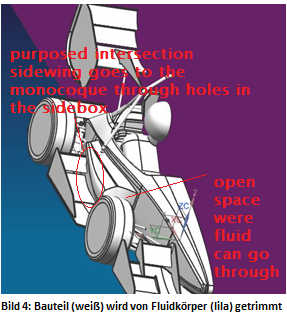When testing the aerodynamic profiles do we assume there are no bending moments, and if not how do you account for the material undergoing stress, shear and bending moments?
I guess for the pure CFD analysis you don’t consider material deformation (in Formula Student, at other levels in industry you definitely do!). However, I’d consider momentum forces (mainly Cm_y) for the mounting design, and you can extract your pressure distribution from the simulation for later structural analysis for your wings and other fragile parts.
What family of aerofoils is most commonly used in Formula Student?
Won’t bending of the wing affect the boundary layer and thus the laminar flow around it? F1 teams “Ferrari” (as I can recall) were using bending moments to increase the camber of their rear wing beyond FIA regulations
You’re totally right. That process involves an iterative design aero-estructures to get the correct shape and pass the mandatory regulations at the same time(some teams like Red Bull even use non-linear deformations to comply with the regulations and take advantages of the deformations at high loads).
However, unless a Formula Student team is able to produce ultra light carbon fiber wings, and they produce enough downforce to considerably bend them, I’d assume that the wings would be “rigid”. I’d focus more on the interaction of the aerodynamics with the vehicle dynamics.
But I’d like to hear what others have to say about this ![]()
Selig S1223 or the RTL modification
During the webinar, my question was sort of forwarded to the forum because I had a question on a simulation for the whole cooling system.
First of all, I would like to know how to deal with the tube hydraulic laws bc I guess we will be dealing with a turbulent flow. That means we will automatically deal with high Reynold numbers. According to the tube hydraulics laws we have to consider the pressure loss which is connected by a value lambda to the laws of Colebrook, Nikuradse, Prandtl or Blasius (due to the fact that we have different materials of our tubes). Therefor I need to give Simscale the information what law it has to consider to calculate with a pressure loss in tubes. Where can I do that? Can it even be considered?
Second of all, I would like to know if Simscale is able to deal with pipe curvatures, valves and size differences (also pressure loss effects are the consequence) and how to do that?
Thank you very much.
I also want to know
Hi Eva,
The laws of Colebrook, Nikuradse, Prandtl or Blasius can only be applied for one dimensional pipe flows. The pressure loss through the radiator, on the other hand, is modeled as a porous media. Hence, we will apply the law of Darcy:
http://www.cfdsupport.com/OpenFOAM-Training-by-CFD-Support/node223.html
Regarding your second question:
SimScale is basically able to simulate pipe curvatures, valves etc. But in general, it is not particularly useful to use 3D CFD simulation for this kind of application? What exactly do you want to simulate?
Cheers,
Milad
Hi Milad,
I would like to simulate the air and water cooling system of accumulator and engines. We got a 4 wheel hub drive and our cooling system is using air coming through the radiator. obviously we got air and water rushing through pumps and pipes to cool the components and we would like to simulate whether the mass flow of air/water and the pressure of flow in the system is reaching out to cool all of our components and there are several pressure loss points in the system such as valves curvatures and sp forth. If it cannot be simulated by a CFD system or does not make sense then this is a pity but we would like to know bc we havent used CFD yet for cooling system simulation. We’ve only used a thermodynamic simulation with thermal FEA yet, not more.
Thank you.
Hi Eva,
This is definitely possible and should help you to improve the performance of your cooling system.
You should take a look at this:
Cheers,
Milad
thank you that helps alot 
